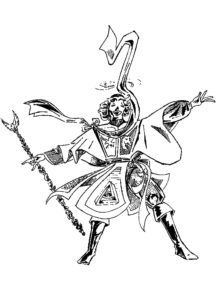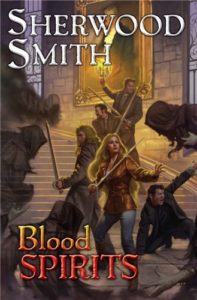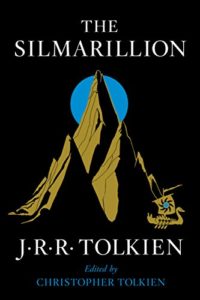This intriguing article is by S. Dorman

Mephisto Prospero In all his glory
The supporting characters mentioned in this piece are wrong. But are they wrong for their stories?
I’ve talked before about wrong characters and how they can be wrong about particular things, or wrong overall in a peculiar way. This piece is a variation, or perhaps further explication, of the idea. Good stories may have a single character that is just right for the story, and fits into it as though made for that story … but, as it turns out, the story is not made for that character. Confused? Let me try, at least, to clarify with some examples.
One of my favorite wrong characters is Miranda’s little brother in Prospero Lost by L. Jagi Lamplighter. Mephisto is engaging as “harebrain,” flippant, and surprisingly helpful, but stunningly, catastrophically—. Yet, I don’t want to “give” this character away. The reader must be as taken up by him as I was.
While reading Blood Spirits by Sherwood Smith I was taken for quite a ride. (And for sleigh rides!) A ride from known mundane life to a glimmery metaphysical reality in which some characters can see vampires and ghosts. But vampires and ghosts are not the “right-wrong” characters I’m talking about in this essay. Nor is the ability of a given character to recognize vampires one of the quirky characteristics I mean here.
 A right-wrong character adds, if not “the salt of the earth,” then a bit of salty taste. —Or can counterbalance all by him-or-herself the ordinariness, even the goodness and reliability, of other characters. The story is really made for these other ordinary characters. Without the “wrong character” there might still be a story, but lacking spice. There is, however, one main character in Blood Spirits that makes the story for me. I’m not saying which one because I don’t want to spoil it. I’ve met him before—in Cornets And Steel. In that story there was yet enough mystery in his, initially, unfathomable cipher to make him merely an unfathomable character. In this sequel, he takes over The Department. The thing is—I want him there … and … I want him not to “win.” We want him there, and we want him wrong. This is what makes him worthwhile. His utter wrongness. His teetering on the edge of rightness, while never quite making it there. Often going catastrophically wrong.
A right-wrong character adds, if not “the salt of the earth,” then a bit of salty taste. —Or can counterbalance all by him-or-herself the ordinariness, even the goodness and reliability, of other characters. The story is really made for these other ordinary characters. Without the “wrong character” there might still be a story, but lacking spice. There is, however, one main character in Blood Spirits that makes the story for me. I’m not saying which one because I don’t want to spoil it. I’ve met him before—in Cornets And Steel. In that story there was yet enough mystery in his, initially, unfathomable cipher to make him merely an unfathomable character. In this sequel, he takes over The Department. The thing is—I want him there … and … I want him not to “win.” We want him there, and we want him wrong. This is what makes him worthwhile. His utter wrongness. His teetering on the edge of rightness, while never quite making it there. Often going catastrophically wrong.
Here is another instance of a “right-wrong character.” His name is Eustace Clarence Scrubb, and he almost deserved it, as the narrator of C.S. Lewis’s Voyage Of The “Dawn Treader” assures us. I do like him there but was not as taken with Lewis’s original storybook version of Eustace Clarence Scrubb as I was taken with the “right-wrong” characters in Prospero Lost and Blood Spirits. It wasn’t until I saw Eustace Clarence Scrubb in the movie version that I saw his true worth. It was a slightly alternate version enlivened by a young character actor (William Jack “Will” Poulter). The movie is a bit like fan fiction, an alternate Narnian universe, but that is out-of-the-way to this idea. Movie Scrubb was in constant, often sotto voce, complaint. Hilariously. It was Eustace Clarence Scrubb who made the movie-story—and I didn’t particularly want him reformed or transformed … until (perhaps) I saw his pain. He was just so entertaining. As entertaining as all his wrongness could possibly make him.
The right character possesses at least some of humanity’s wrong qualities, whether in action, tone, motivation, attitude, or speech. Something quirky. (Although morality is part and particle of everything, I’m not here specifically referencing it.) Writers may throw lots of quirky characters into a story, but generally I prefer one per story—and for most of the other characters to be reasonable, inoffensive, kind—even if mistaken. These other characters are people the reader might like knowing in real life. So in that sense they are “right,” in having good character. But in storybooks we can handle characters that we might not otherwise like coming into our homes.
My next example is from the real life just mentioned. I don’t mind declaring him, because, like many quirky characters, he sought sensational attention and got it. He even wanted (it seems to me) to justify the attention by bringing a U.S. scholar to court for, as he construed, libel. Until recently, in the UK, people from other countries could be brought to court for defamation without evidence. Instead of the reverse—plaintiff proving defamation—it was then incumbent on one sued to show in court the truth of what they’d published.
This real life wrong person was the infamous holocaust denier David Irving, accused in print by Deborah Lipstadt of deliberate malicious historical distortion. And with the help of her publisher and friends, heroically she submitted to the legal challenge without the necessity to do so. The proceedings, buildup, and fallout, are recorded in her book, History On Trial. Should I confess a lack of interest, not in this experience or its outcome—of which I might instead have read a condensed version? But it was so. I began reading Lipstadt’s book, and read on, recognizing solemn moving experience and learned some important things…. But I was not taken up into the story until she brought the outrageous David Irving onstage to make the story live for me. His claims, of course, were absurd and damning to his reputation, but his was not a cold silent righteous stubborn character. Instead, at one point claiming to have been branded with a yellow star, he was a walking, talking hilarious absurdity. His outrageously grandiose comic presence made the book. Made it riveting. His presence ludicrously engaged the reader—me. When asked if Irving might settle, one counselor said in disgust that he had quit trying to understand what this guy would do.
You don’t want them to win, however. You may not even want them repentant, transformed. It’s in the nature of these entertaining, intriguing, or moving stories. Or is it in the nature of Story itself?
Take the story of The Hobbit, or even the hobbit himself, Bilbo Baggins. An exception? While enjoying Mythgard Academy’s free video recordings of lectures on Tolkien’s Unfinished Tales, I was learning again about JRRT’s three versions of “The Quest of Erebor.” These draft versions are very interesting, and, I fear, a little like Tolkien’s own judgment of the “Council of Elrond” chapter in The Fellowship of the Ring—too much (perhaps deadening) explanation. These draft versions were Tolkien’s attempts to re-contextualize the story of the hobbit into both The Lord Of The Rings and the story of Middle-earth itself. But I loved that wrong scene!
 While Gandalf was talking with his friends about Bilbo’s coming into this great story from the obscurity of the Shire—the hobbit’s preposterous unsuitability to burglarize a dragon is again mooted. One thing Dr. Corey Olsen emphasized in the lecture is that there was “no plan.” Gandalf sometimes characterizes his muddied inspiration and attempt at bringing Bilbo into dealings with dwarves as “desperate” and “absurd.” It was, however, “meant” to happen. The re-contextualized literary conceit has Bilbo writing the first part of There and Back Again in self-mockery; with Gandalf afterward remembering him as a young hobbit, loving adventure and elvish visits, but finding him sadly changed.
While Gandalf was talking with his friends about Bilbo’s coming into this great story from the obscurity of the Shire—the hobbit’s preposterous unsuitability to burglarize a dragon is again mooted. One thing Dr. Corey Olsen emphasized in the lecture is that there was “no plan.” Gandalf sometimes characterizes his muddied inspiration and attempt at bringing Bilbo into dealings with dwarves as “desperate” and “absurd.” It was, however, “meant” to happen. The re-contextualized literary conceit has Bilbo writing the first part of There and Back Again in self-mockery; with Gandalf afterward remembering him as a young hobbit, loving adventure and elvish visits, but finding him sadly changed.
It is Bilbo who unwittingly galvanizes the union of forces against ploys of the necromancer in the hobbit’s story. Both outside and inside the narrative, this is the contextualization of The Hobbit. But another outside-the-text element: The absurdity of The Hobbit: There And Back Again is the absurdly right entrance into JRRT’s cosmogony. Bilbo Baggins, seemingly on the periphery of it all, yet definitely necessary to the win. Would anything ever have been published without it? Given the aesthetic culture of that day? We know that LotR could not have emerged because it derives from that story. And, literarily, The Hobbit itself is something of an incongruous construction, as others have pointed out. One of my friends, formerly enamored of it, declares its cheesiness upon a subsequent reading. Yet I can’t help loving that in it. In fact, though I’ve known the Silmarillion well and written elvishly accurate fan fiction, I like
“O! tril-lil-lil-lolly
the valley is jolly,
ha! ha!”.
…And do not find this intro to elves at the bridge, as Bilbo and the Dwarves are reaching Rivendell, unsuitable. Some scholars do. For them it is out of place and wrong. I think it shows a needful aspect of Middle-earth elves that’s really there in the elves. Elves don’t think much about those categories of being—hobbits and dwarves. …Nor that strange character, Man.
*
This essay is part of a collection on writerly creativity seeking a publisher at Christian Manuscript Submissions and elsewhere.
© S. Dorman, is author of science fiction spun off her Master’s thesis in humanities from California State University Dominguez Hills. (The thesis revolved around the Christian foundation of the humanities.) Author of Gott’im’s Monster —links to ebook.
Visit S. Dorman’s Author Page.

